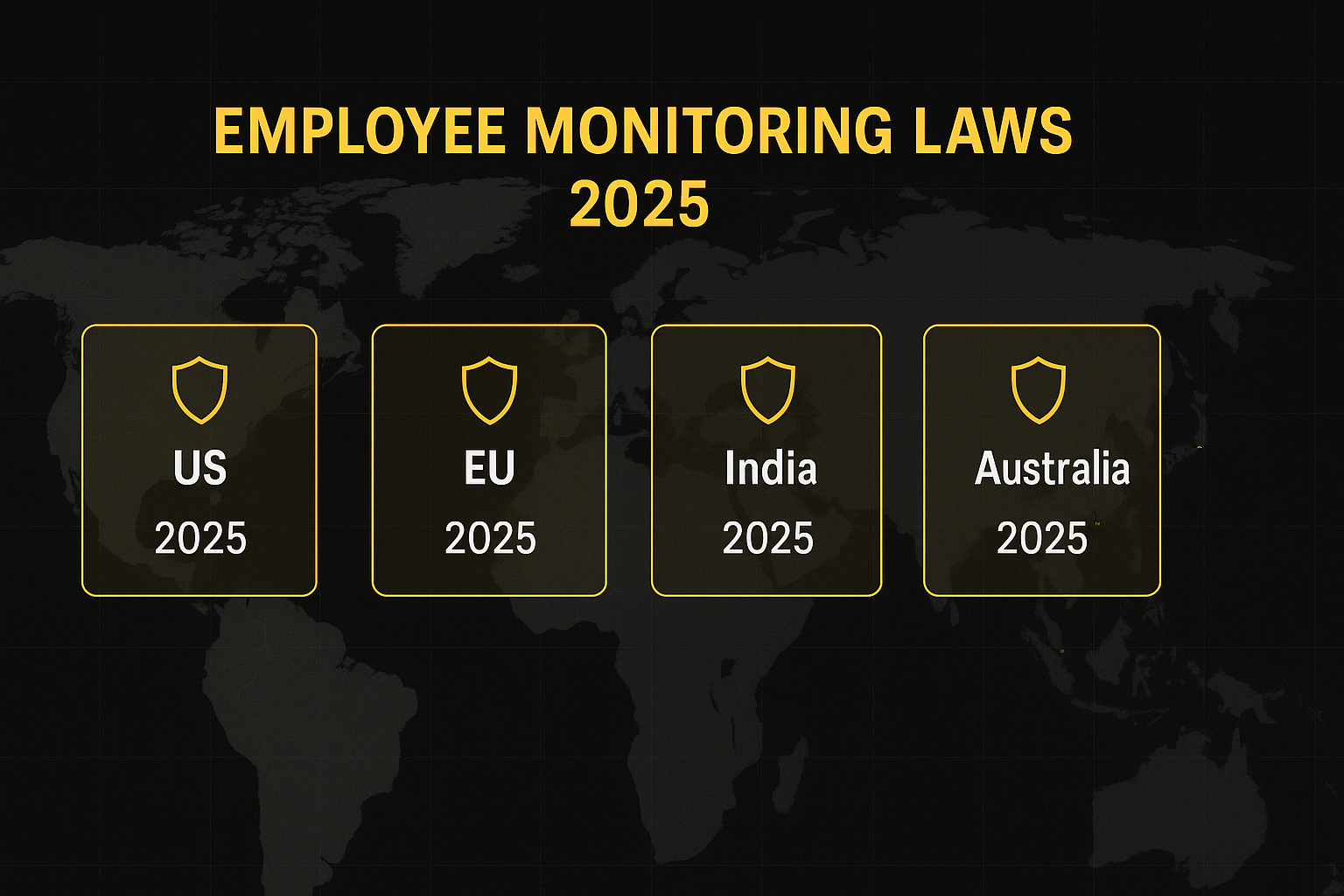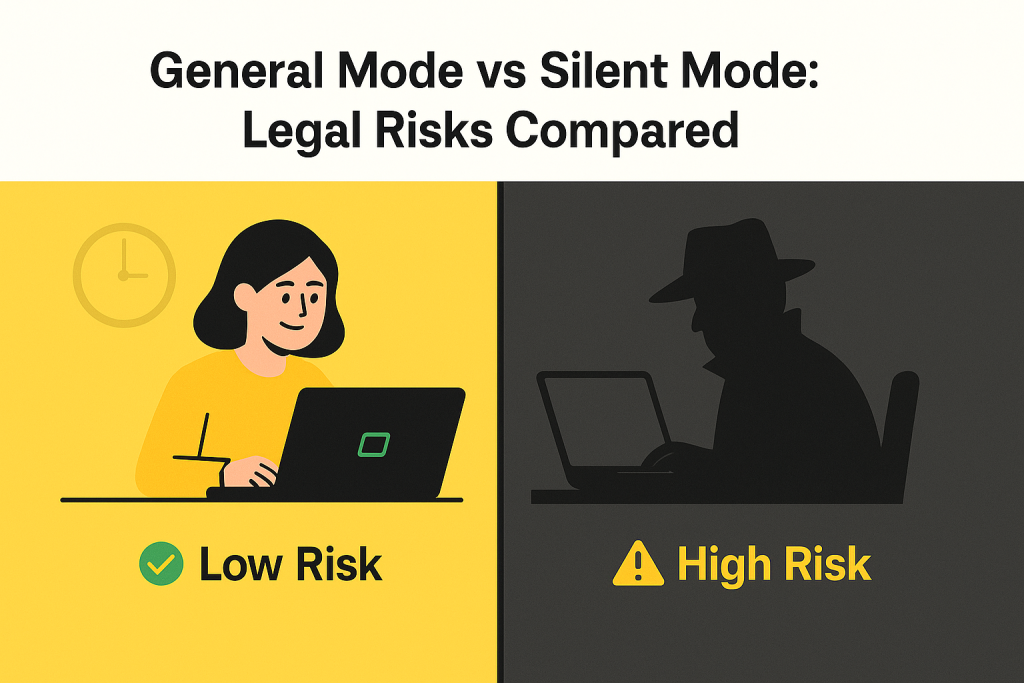Employee Monitoring Laws 2025: Compliance & Productivity with SuperSee
Employee Monitoring Laws 2025 are reshaping how businesses use surveillance tools in the workplace. With remote work on the rise, GDPR, HIPAA, India’s DPDP Act, and others now demand stricter compliance. SuperSee helps businesses adapt with dual-mode monitoring that ensures productivity and legal peace of mind.

Employee surveillance has skyrocketed post-pandemic—but so have lawsuits and investigations. As of mid-2025, over 60% of large employers use digital monitoring tools, yet 63% of workers say invasive tracking would drive them to quit. Governments worldwide are tightening workplace surveillance laws. From GDPR to HIPAA to India’s new DPDP Act, compliance is no longer optional—it’s a liability risk.
Understanding Employee Monitoring Laws 2025 is essential for any global workforce strategy. This guide breaks down key global laws, explains the difference between Silent Mode and General Mode, and shows how SuperSee’s built-in safeguards make compliance easy.
Why Employee Monitoring Is Growing in 2025
In the hybrid era, leaders struggle with visibility, security, and output.
- 85% of managers worry they lack visibility into remote worker productivity (Microsoft WorkLab).
- 60% of firms already use “bossware” to track digital activity—and it’s projected to rise to 70% by 2025.
- Boards demand productivity metrics, while regulated sectors require audit trails (HIPAA, FINRA).
Monitoring serves four key goals:
- ✅ Productivity Trends – Time-on-task analytics, coaching opportunities.
- ✅ Security & IP Protection – Screenshots, clipboard logs for insider threat detection.
- ✅ Regulatory Compliance – Trade supervision, healthcare audit trails.
- ✅ Investigation Support – Logs for fraud, harassment, and misconduct probes.
General Mode vs Silent Mode: Legal Risks Compared

| Mode | How SuperSee Works | Typical Use-Cases | Legal Exposure |
| General Mode | Visible tray icon + time widget. Employees can review their working hours, apps and internet usage.. | Routine productivity metrics, regulated audit logs. | ✅ Low to moderate. Compliant with GDPR, PIPEDA, many U.S. states. |
| Silent Mode | No on-screen cues. Admin must install a different application in the devices they choose for silent monitoring. | Fraud, IP theft or insider-threat probes. | High. Often banned unless limited to a formal investigation (EU/UK) or accompanied by specific warrants (NSW,AU) |
🔐 SuperSee logs every Silent Mode activation and allows per-device controls to meet global audit standards.
Global Legal Snapshot (2025)
United States
- Federal: Electronic Communications Privacy Act (ECPA) allows monitoring of employer-provided systems but is tempered by tort claims for “intrusion upon seclusion.” Refer ico.org.uk
- State notice laws:
- New York (S2628, 2022): Written notice on hire + poster; civil fines $500–$3,000. Refer nysenate.govhklaw.com
- Connecticut: Mandatory written/e-mail notice for private employers.portal.ct.gov
- Delaware § 705: One-time written or electronic notice, employee acknowledgment required. Refer law.justia.com
- Utah SB 231 (2024): Limits certain public-sector covert surveillance; presages private-sector debate. Refer le.utah.gov
- Sector overlays: HIPAA requires audit trails of e-PHI; FINRA Rule 3110(c) mandates trade supervision.
European Union / European Economic Area
- GDPR Articles 6 & 88: Employers rely on “legitimate interest” but must prove proportionality and run a Data-Protection Impact Assessment (DPIA) for high-risk monitoring. Refer autoriteitpersoonsgegevens.nlico.org.uk
- Works councils (DE, FR, NL) can veto monitoring policies. Refer autoriteitpersoonsgegevens.nl
United Kingdom
- UK Data Protection Act 2018 + ICO “Monitoring at Work” Guidance (Oct 2023): Transparent mode is default; covert allowed only when “strictly necessary,” tightly scoped, and time-limited.ico.org.uk
Canada
- PIPEDA: Consent exceptions exist for managing employment relationships, but meaningful notice and purpose limitation remain. Refer priv.gc.ca
- Ontario ESA (Working for Workers Act 2022): Employers ≥ 25 staff must publish a written electronic-monitoring policy. Refer ontario.caontario.ca
Australia (NSW)
- Workplace Surveillance Act 2005: 14 days’ written notice; covert surveillance is a criminal offence without a magistrate-issued warrant. Refer legislation.nsw.gov.aulegislation.nsw.gov.au
India
- Digital Personal Data Protection Act 2023 (full enforcement 2025): Allows processing for “employment purposes,” yet silent surveillance likely requires a “legitimate use” security exemption plus robust audit logs. Refer impriindia.comdataguidance.com
United Arab Emirates
- Federal Decree-Law 45/2021 (PDPL) + DIFC DP Law 2020: Written notice and purpose specification mandatory; data-transfer clauses needed for foreign hosting. Refer uaelegislation.gov.aedataguidance.com
Emerging Regimes
- Brazil LGPD treats employee data as “personal data”—monitoring allowed on legitimate grounds but must respect data-subject rights. Refer worktime.com
- Japan APPI requires specifying monitoring purposes in employment rules and ensuring proportionality. Refer dataguidance.com
- South Africa POPIA obliges employers to notify staff and justify necessity for any continuous monitoring. Refer equitablegrowth.org
Tip: Always apply the strictest applicable law when staff sit in multiple regions.
Common Restrictions & Grey Zones
- 📏 Proportionality & Data Minimization –Always capture only what’s necessary. SuperSee does not log keystrokes or provide live webcam streams. For configured devices, you can schedule periodic webcam snapshots (e.g., for exam proctoring).
- 🕒 Off-Hours Privacy – Many laws prohibit surveillance outside working hours. SuperSee lets employees start and stop their own monitoring sessions. When stopped, no data is recorded, ensuring complete off-time privacy.
- 🧬 Biometrics – Webcam images are “special category” data under GDPR/UK DPA, requiring extra justification and secure handling.
- BYOD Devices – If employees use personal devices, we recommend they create a separate “work” user account and install SuperSee only on that profile. This isolates personal activity from work monitoring and simplifies consent management.
- Retention Limits – A 90-day retention period is standard across most jurisdictions. Data older than 90 days is auto-purged; anything beyond requires documented justification and a DPIA.
- Union / Works-Council Approval – In several EU countries and Quebec, monitoring policies must be approved by employee unions or works councils.
How SuperSee Becomes Your Compliance Co-Pilot
SuperSee is designed with Employee Monitoring Laws 2025 in mind, ensuring compliance across jurisdictions.
| Legal Requirement | SuperSee Capability |
| ✅ Transparent Monitoring | In General Mode, employees see a tray icon and toast notifications. Admins can link a visible monitoring policy. |
| ✅ Employee Consent & Awareness | Employees can start/stop monitoring manually, with clear visibility into when tracking is active. |
| ✅ Retention Policy Enforcement | SuperSee auto-purges all captured data after 90 days. Admins can override this only with proper audit trails. |
| ✅ Data Minimization | Configure what to record—screenshots, time logs, websites. SuperSee does not capture keystrokes or full webcam feeds. |
| ✅ Secure Cloud Access | Screenshots and analytics are securely uploaded to the SuperSee cloud, encrypted in transit and at rest (AES-256). Admins access them via a secure dashboard. |
| ✅ Separate Silent Mode App | For sensitive investigations, Silent Mode is deployed as a completely separate application by your admin team—fully logged and auditable. This ensures Silent Mode is never activated accidentally or without proper documentation. |
| ✅ Privacy by Design | SuperSee follows privacy-first principles: no hidden processes, no background keyloggers, clear user controls, and cloud storage limited to defined monitoring parameters. |
Monitoring Compliance Checklist for Businesses Using SuperSee
📋 Implementation Checklist for Businesses Using SuperSee
Set up employee monitoring that’s compliant, transparent, and scalable across global jurisdictions. Follow this 11-step guide to deploy SuperSee with best practices built-in.
✅ 1. Draft or Update Your Monitoring Policy
- Include: purpose, scope, what will be recorded (e.g., apps, screen), when it applies, and how long data is retained.
- Clarify General Mode vs Silent Mode, BYOD recommendations, employee rights, and who can access the data.
✅ 2. Run a Data Protection Impact Assessment (DPIA)
- Required under GDPR, UK DPA.
✅ 3. Choose the Right Monitoring Agent
- SuperSee offers multiple agent types — pick based on your compliance risk and IT policies:
- Standard Agent (General Mode): Always-visible monitoring with employee transparency.
- Silent Agent (For Investigations): A separate application deployed only with internal case documentation.
- Admins can assign different agents per employee from the admin portal.
✅ 4. Install SuperSee on Target Devices
- Install only on company-managed devices or clearly consented BYOD profiles.
- Ensure tray icon and first-use notifications appear in General Mode to comply with transparency laws.
✅ 5. Configure Monitoring Rules Per Employee
- SuperSee allows granular settings per user:
Choose if you want to track screenshots, or timelogs, or application usage or website usage or all as per your needs for every employee.- Set capture intervals (e.g., 1 per 10 mins)
- Enable or disable webcam snapshots
- Define settings by department, job role, or compliance need.
✅ 6. Set Work Hours & Off-Time Scheduling
- Laws in the EU, US, and Canada prohibit off-hours surveillance.
- Use SuperSee’s scheduler or let employees start/stop monitoring themselves.
- No data is captured while the session is off.
✅ 7. Apply 90-Day Retention Limit
- SuperSee’s default data retention is 90 days, aligned with best practices.
- Longer retention requires written justification and may trigger compliance review (e.g., GDPR DPIA, India DPDP, UAE PDPL).
- Admins can enforce auto-purge policies globally or per group.
✅ 8. Post Required Notices or Send Written Consent
- New York: Poster in workplace
- Connecticut/Delaware: Email or written consent
- Australia (NSW): 14-day written notice before starting
- Always provide a written notice before deploying Silent Mode agent.
✅ 9. Recommend BYOD Setup (If Applicable)
- For employees using personal devices:
- Ask them to create a dedicated “Work” user in their device. They shall login to only that user in their device for work.
- Install SuperSee only within that profile
- This isolates work tracking from private use and reduces legal risk.
✅ 10. Train Your Managers & Admins
- Teach managers how to:
- Use the productivity dashboard instead of relying on screenshots
- Interpret trend analytics (active time, focus hours, etc.)
- Apply monitoring only for legitimate business reasons
- Document the training as part of your compliance efforts.
✅ 11. Schedule an Annual Policy & DPIA Review
- Re-audit your monitoring program at least once per year.
- Re-run the DPIA whenever:
- Your tools or practices change
- Local privacy laws update
- You expand monitoring to a new region
💡 Pro Tip:
SuperSee helps you stay proactive with compliance by offering one-click employee data exports, tamper-proof logs, and geo-aware settings for multinational teams.
Glossary
DPIA – Data-Protection Impact Assessment documenting risks & mitigations for high-risk processing.
Legitimate Interest – GDPR legal basis requiring a balancing test between employer needs and worker rights.
Covert Surveillance Authority – NSW magistrate’s warrant authorizing hidden monitoring.
Special Category Data – GDPR term for sensitive data (e.g., biometrics).
Ready to Monitor—Without the Lawsuit?
SuperSee’s dual-mode architecture, compliance checklist, and region-wise legal controls give you productivity insights and peace of mind.
To see how SuperSee helps you align with global monitoring laws in 2025, book a demo with us.
Citation URLs
https://apploye.com/blog/employee-monitoring-statistics/
https://www.raconteur.net/future-of-work/employee-monitoring-staff-response
https://ico.org.uk/about-the-ico/media-centre/news-and-blogs/2024/02/ico-orders-serco-leisure-to-stop-using-facial-recognition-technology/
https://www.theguardian.com/business/2024/feb/23/serco-ordered-to-stop-using-facial-recognition-technology-to-monitor-staff-leisure-centres-biometric-data
https://www.microsoft.com/en-us/worklab/work-trend-index
https://www.nysenate.gov/legislation/bills/2021/S2628
https://portal.ct.gov/das/knowledge-base/articles/services-for-state-agencies/general-letters/electronic-monitoring-notice
https://law.justia.com/codes/delaware/title-19/chapter-7/subchapter-i/section-705/
